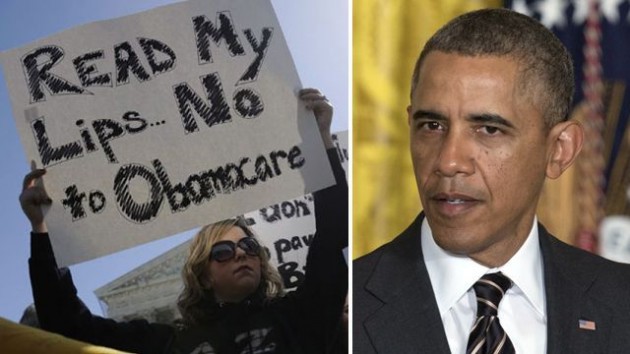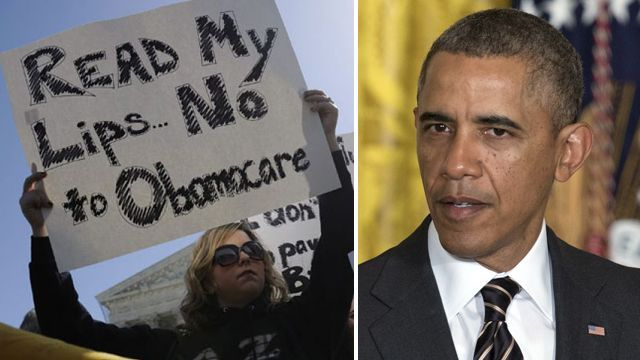

A slew of reports released with under 50 days to go before Election Day are leading many to question whether ObamaCare is even achieving it’s stated goals. Despite Democrats’ attempts to underscore various successes, data are suggesting the negative perceptions of the law that remains deeply unpopular among the American people is largely due to reality, and not simply the result of various public relations campaigns.
ObamaCare’s Impact On Jobs
The Congressional Budget Office released a revised report back in February claiming nearly 2.5 million workers will opt out of full-time jobs because ObamaCare incentivizes them to do so — while leading employers to eliminate 2.3 million full-time jobs in the next ten years. According to jointly conducted surveys by several regional Federal Reserve Banks, these figures may be too low.
“Roughly one fifth are saying they’re moving from full time to part time,” Health economist John Goodman noted. “More than one in ten are saying they’re doing more outsourcing – all this because of the new health care reform.”
Republicans have long predicted this affect from the law. House Speaker John Boehner, who once called ObamaCare a “job killer,” said the report showed how “the middle class is getting squeezed in this economy.”
The negative impact appears to be hitting small businesses that have between 20 and 49 employees, which traditionally, have driven economic growth and job creation. Nearly 74 percent of all jobs created are created by small businesses in the United States.
“You get a negative impact on jobs, you get a negative impact on wages in those jobs,” said Doug Holtz-Eakin, the former Director of the Congressional Budget Office. “What this means for small business as a whole is over $22 billion of earnings gone for their workers and 350,000 jobs.”
It is worth noting that the Congressional Budget Office has a long history of giving projections of new government programs that fall short actual results. Even though the president has repeatedly and unilaterally delayed the small business mandate, which requires businesses with more than 50 employees to provide insurance, businesses are preparing and already 1) avoiding hiring to keep their worker rolls below 50 and, 2) hiring for part-time positions that runaround the mandate.
In a review of the August jobs report, not only did the 5-year trend of disappointment after slight second quarter growth continue, but also the trend of part-time job creation inflation optimism in the labor market. Again, this is nothing new. Even a report from the Centers for Medicaid and Medicare Services back in February said ObamaCare premium increases were estimated to hit nearly two-thirds of all small businesses, the single-biggest source of jobs for working Americans in the U.S. economy.
“The 30-hour cutoff is how the administration determines whether you’re full time or part time,” Goodman noted. “And so we see this everywhere that people are restricted, they’re pushed below 30 hours, they count as part time and when they’re part time, the employer doesn’t have to provide health insurance.”
Increasing Costs
The increased costs associate with the health care law include a variety of sectors in the U.S. economy, most of which will directly impact working consumers. Premium increases, other health care costs, producer prices and the taxpayer burden have all exceeded economists’ predictions made during the health care debate.
In February of 2014, the CBO was forced to backtrack from their initial cost projection of the new government entitlement. President Obama and congressional Democrats had been citing the CBO projection to support their claim that the Affordable Care Act, otherwise known as ObamaCare, would reduce the deficit by more than $120 billion over the next decade. However, the CBO no longer stands by that claim.
“CBO and JCT can no longer determine exactly how the provisions of the ACA that are not related to the expansion of health insurance coverage have affected their projections of direct spending and revenues,” the CBO wrote in a widely ignored footnote.
Much has been made about the increases in premiums due to the law. A recent study conducted by healthcare analysts at Morgan Stanley found health insurance premiums increased at the highest rate ever measured by the firm. The survey of 148 brokers concluded health insurance premiums increase under ObamaCare because of ObamaCare, blatantly stating “increases are largely due to changes under the ACA.” In states such as Florida, for instance, their predictions appear to be coming to fruition.
Regulators in the state of Florida said in August that a majority of the state’s health insurers have proposed higher rates for 2015. Insurance premiums under ObamaCare in the Sunshine state will rise an average of 13.2 percent, according to the Florida Office of Insurance Regulation.
Is It Even Worth It?
The entire justification for the government takeover and remaking of the health care industry was supposedly to cover a claimed 47 million who were uninsured. That number, itself, was based upon misleading data, including people who lost health coverage and were statistically likely to receive Cobra coverage while in between jobs, illegal immigrants, and so on.
The Centers for Disease Control and Prevention said in a report Tuesday that the law reduced the percentage of people in the U.S. without health insurance by just two percentage points this year. A separate report released by the U.S. Census Tuesday found that about 42 million Americans were uninsured last year. But the Census’s data isn’t as current as the CDC’s, and was meant to serve as a baseline after a widely criticized report failed to live up to critic scrutiny.
The agency changed its methodology after 2012, when it said 48 million people lacked insurance. This, experts say, suggested an artificially inflated drop in the uninsured rate. Further, unlike the data from the Centers for Disease Control and Prevention, the Census report includes people over age 65 who already have health coverage through Medicare.
Regardless, even if we are to take these numbers at face value, both reports fall woefully short of expectations and promises made by proponents of the law. The law was supposed to reduce the health care cost burden to the federal budget and to the individual consumer, but neither will see those savings.
The law was also supposed to address the over-use of Emergency Room visits, but across the nation hospitals are reporting an explosion of ER visits due to ObamaCare. A Harvard study released in early 2014 warned of this inevitability.
The president and congressional Democrats rammed through an unpopular bill hedging on the possibility that public opinion would change when the positive impact of the law were realized. But, as the polls and reports clearly show, that has yet to happen.








jb1111 / September 23, 2014
All Democrats are LYING, CHEATING CHICAGO THUGS.
/